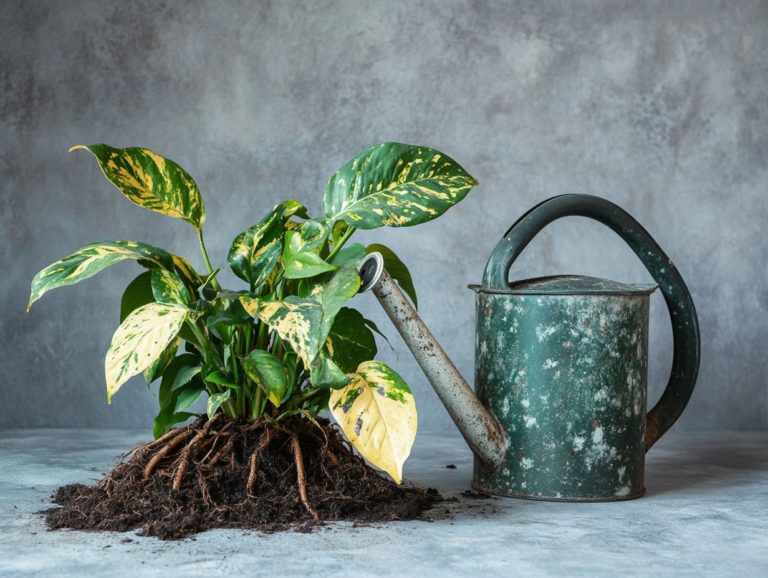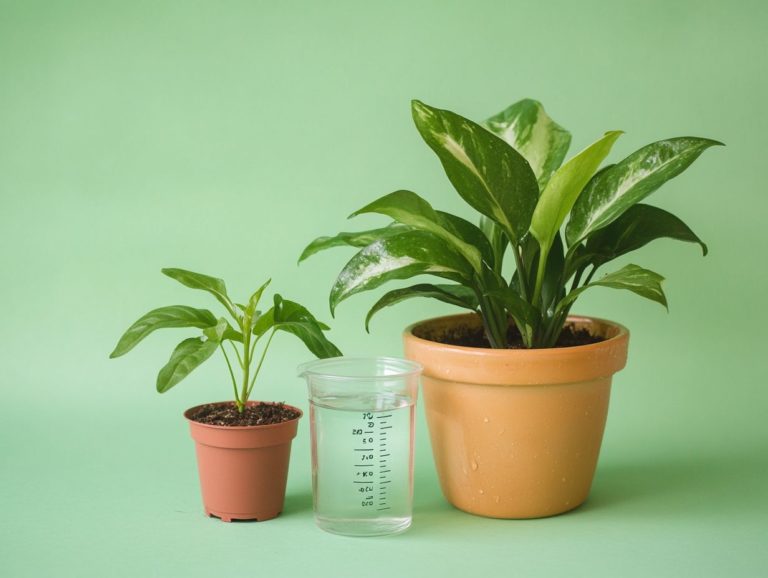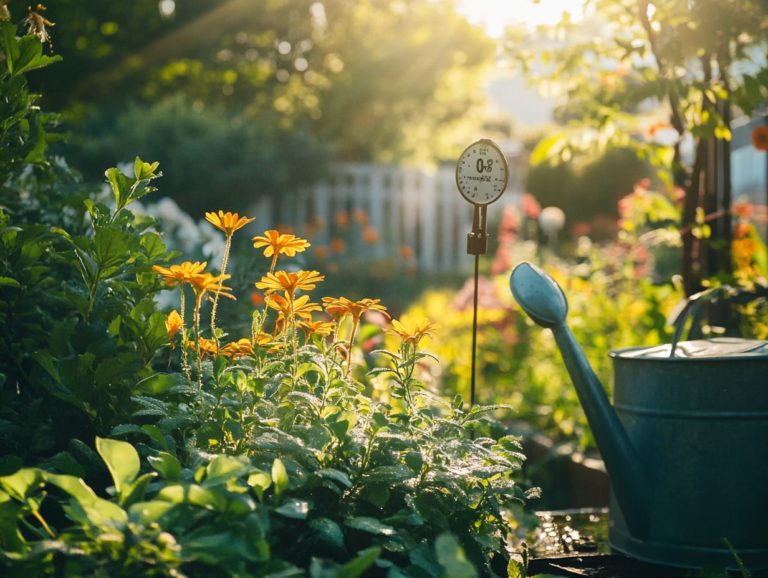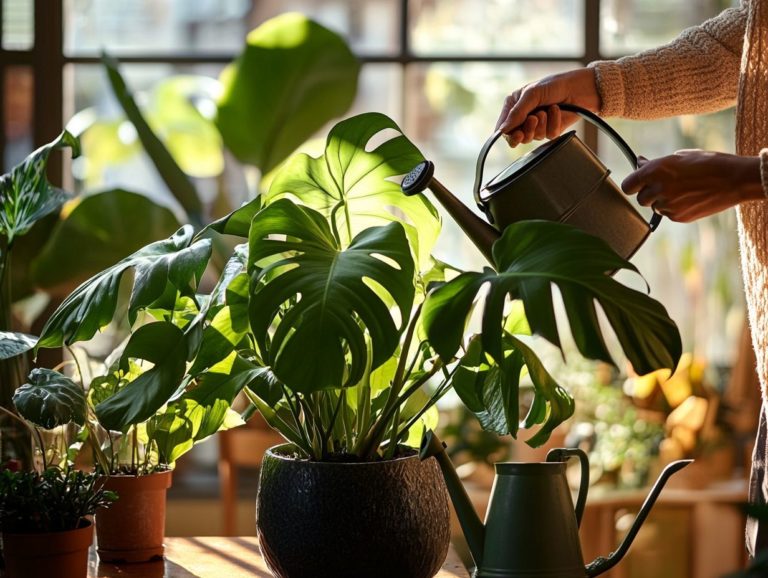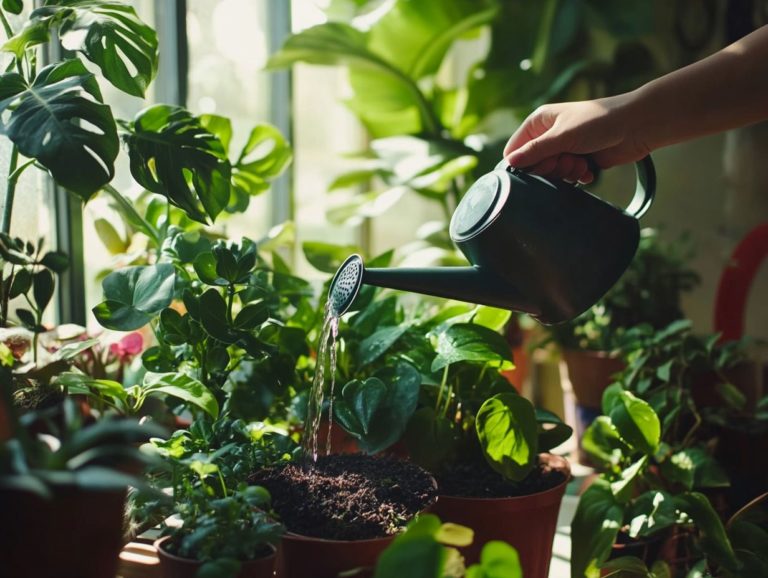How to Adapt Your Watering in Different Climates
Watering your plants isn t a one-size-fits-all endeavor, especially given the diverse climates at play. Knowing how environmental factors impact watering needs is key for any dedicated gardener.
Whether you re facing the relentless sun of arid regions or the sticky humidity of rainy climates, each scenario presents its own challenges and strategies.
This article explores effective watering techniques tailored for hot, humid, cold, and moderate climates. You ll learn how to cultivate a flourishing garden, regardless of your location. Optimize your watering practices to ensure your plants not only survive but thrive!
Contents
- Key Takeaways:
- Understanding Watering Needs in Different Climates
- Watering Strategies for Hot and Dry Climates
- Watering Strategies for Humid and Rainy Climates
- Adapting Watering Practices for Cold and Snowy Climates
- Tips for Efficient Watering in Moderate Climates
- Frequently Asked Questions
- What factors should I consider when adapting my watering routine in different climates?
- How often should I water my plants in a hot and dry climate?
- Should I adjust my watering schedule during the rainy season?
- What is the best time of day to water plants in a humid climate?
- Can I use the same amount of water for all my plants in different climates?
- What are some signs that I need to adjust my watering routine in a new climate?
Key Takeaways:

- Consider factors like temperature, humidity, and precipitation when figuring out watering needs.
- In hot, dry climates, conserve water with drip irrigation and mulch.
- In humid, rainy areas, manage water with rain gardens and proper drainage.
Understanding Watering Needs in Different Climates
Knowing how much water your plants need in different climates is key to a thriving garden. Each plant species has specific watering needs to maintain optimal soil moisture levels.
Factors like temperature, humidity, and the local environment can significantly impact how often and how you should water. Whether you’re tending to a desert landscape like Las Vegas or a humid coastal area, grasping these intricacies can help conserve water and boost plant health.
By understanding these factors, you re paving the way for a successful and sustainable gardening journey.
Factors that Affect Watering Requirements
Several key elements influence your watering requirements for plants, including soil moisture content, temperature, humidity levels, and the specific species you re cultivating.
Understanding how these elements interact is essential for your plant care success. Soil moisture content plays a crucial role; overly dry or saturated soil can harm root health and nutrient uptake. Temperature affects evaporation rates, meaning those hot days might call for more frequent watering.
Higher humidity can alter your plant’s transpiration rate (the process by which plants lose water vapor), allowing for less water absorption from the soil. It’s important to consider the specific needs of different species; some thrive in dry conditions, while others require consistently moist soil.
By skillfully balancing these factors, you can optimize your watering routines and promote healthier plant growth.
Watering Strategies for Hot and Dry Climates
In hot and dry climates, mastering effective watering strategies is crucial for conserving water while ensuring your plants receive the moisture they need to flourish. You must adapt your methods to tackle the unique challenges posed by high evaporation rates and temperature fluctuations.
For instance, using drip irrigation targets plant roots more efficiently than traditional overhead systems. Adding mulch helps retain moisture in sandy soils.
Embrace these strategies to boost your plants health and practice smart water management. Your garden will thank you!
Effective Techniques for Conserving Water

Conserving water in your gardening efforts is crucial, especially in areas prone to high evaporation rates. Fortunately, several effective techniques can help you achieve this goal while ensuring your plants remain healthy and vibrant.
One of the simplest yet most impactful methods is the strategic use of mulch. This not only cuts down on evaporation but also suppresses pesky weeds and enriches the soil with organic matter over time.
Adjusting your watering frequency according to the season and the unique needs of your plants can lead to substantial water savings. By incorporating smart irrigation systems, like drip irrigation or automated timers, you can enhance efficiency by delivering water directly to the root zone while minimizing waste.
By embracing these strategies, you can significantly reduce your water consumption while maintaining a thriving landscape.
Watering Strategies for Humid and Rainy Climates
In humid and rainy climates, you ll love how easy it is to boost plant health by tailoring your watering strategies to account for the excess moisture. Monitor soil conditions closely, as overwatering can lead to root rot and other health problems for your plants.
Understanding the unique challenges of these environments like managing soil salinity, which is the salt concentration in the soil, and ensuring proper drainage is crucial for effective irrigation. It may seem strange, but knowing when to check and adjust your watering schedule can significantly enhance plant health and optimize moisture levels in the soil.
Challenges and Solutions for Water Management
Water management in humid and rainy climates poses unique challenges that call for tailored solutions. You need to ensure that your plants receive just the right amount of moisture without the risk of drowning them in excess water.
In these environments, the threat of mold growth and soil saturation is a significant concern, potentially leading to plant diseases that can devastate your gardens and landscapes.
To address these concerns, one effective strategy is to enhance soil drainage by installing French drains structures that redirect water away from plants or opting for raised beds. These techniques can help divert excess moisture away from the root zone, keeping your plants healthy.
Choosing drought-resistant plant species can also lessen your reliance on constant irrigation, making your gardens more resilient. Additionally, incorporating smart irrigation systems that adapt to weather data can further reduce the risk of overwatering. For a more sustainable and thoughtful approach to garden care, consider watering in different seasons.
Adapting Watering Practices for Cold and Snowy Climates
Adapting your watering practices for cold and snowy climates is essential for ensuring that your plants endure the harsh winter months. Freezing temperatures can dramatically impact soil moisture levels and root health, making it imperative for you to take protective measures.
Consider covering your plants with mulch or fabric to retain warmth and moisture, and be sure to adjust your watering schedule to reflect the reduced evaporation rates that accompany colder weather.
By understanding the specific needs of your plants during winter, you set the stage for a flourishing garden come springtime.
Dealing with Freezing Temperatures and Snow Accumulation

Managing freezing temperatures and snow accumulation in your garden can pose quite a challenge, as these conditions affect both the soil and your plants, requiring you to pay close attention to moisture levels and protective measures.
To protect your vibrant blooms and lush greenery, consider implementing a variety of strategies. One effective approach is proper mulching, which not only insulates the soil but also aids in moisture retention during dry spells. Choosing plants that thrive in cold climates can significantly enhance their resilience.
For instance, incorporating perennials that flourish in low temperatures can bolster your garden’s winter hardiness. Employing simple techniques, such as draping vulnerable plants with burlap or frost cloth, can provide essential protection against sudden temperature drops and heavy snowfall.
Tips for Efficient Watering in Moderate Climates
Efficient watering in moderate climates requires a thoughtful approach. Consider factors like humidity and rainfall patterns.
Prioritize monitoring soil moisture and adjust your irrigation schedules. Techniques like water conservation and technology can enhance your gardening efforts.
By tuning in to your plants’ specific needs, you can cultivate vibrant gardens while using less water.
Balancing Water Needs with Climate Conditions
It’s essential to balance your plants’ water needs with changing climate conditions. Each species has unique requirements that shift with the seasons.
Observe the specific demands of each plant and adapt to environmental factors affecting soil moisture. For example, drought-resistant succulents need less water than moisture-loving ferns.
Temperature, humidity, and rainfall can change how often you need to water. Using mulch helps retain soil moisture.
Check soil moisture levels with a probe regularly. This helps you adjust your watering schedules based on the needs of your garden.
Frequently Asked Questions
What factors should I consider when adapting my watering routine in different climates?

When adapting your watering routine, consider the soil type, plant species, temperature, humidity, and rainfall patterns in your area.
How often should I water my plants in a hot and dry climate?
In hot and dry climates, water your plants 2-3 times a week, as the soil dries out quickly. Be careful not to overwater, which can cause root rot.
Should I adjust my watering schedule during the rainy season?
Yes, reduce your watering during the rainy season. Your plants will get enough water from the rain, and overwatering can lead to diseases.
What is the best time of day to water plants in a humid climate?
In humid climates, water your plants early in the morning or late in the evening. This timing prevents excess evaporation and helps plants absorb water better.
Can I use the same amount of water for all my plants in different climates?
No, adjust the water amount based on each plant’s needs and the climate. Some plants need frequent watering, while others thrive on less.
What are some signs that I need to adjust my watering routine in a new climate?
Watch for drooping or yellowing leaves, wilting, or stunted growth. These signs indicate that your plants may not be getting enough water. Adjust your routine to help them thrive.

